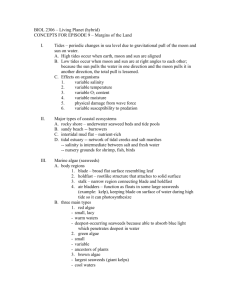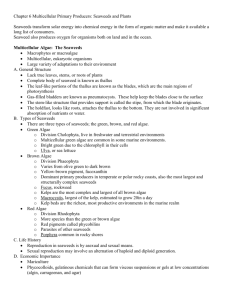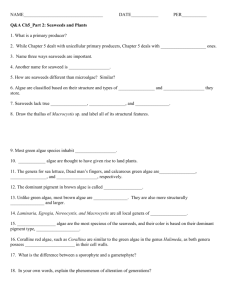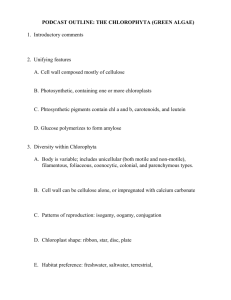View/Open - Oregon State University
advertisement
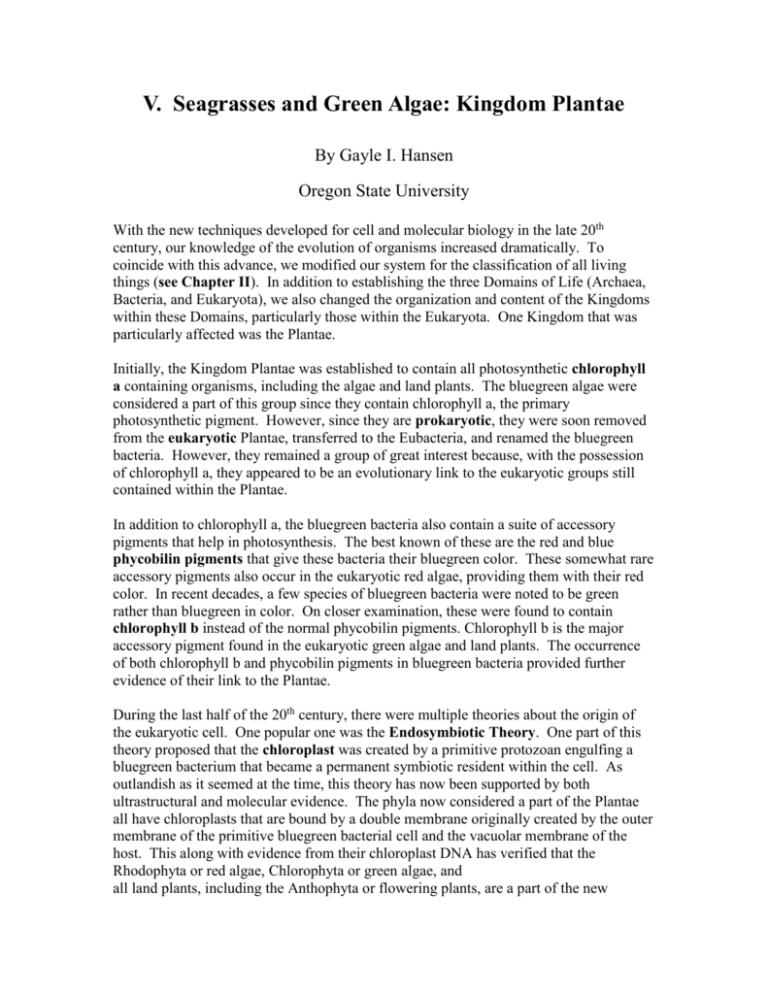
V. Seagrasses and Green Algae: Kingdom Plantae By Gayle I. Hansen Oregon State University With the new techniques developed for cell and molecular biology in the late 20th century, our knowledge of the evolution of organisms increased dramatically. To coincide with this advance, we modified our system for the classification of all living things (see Chapter II). In addition to establishing the three Domains of Life (Archaea, Bacteria, and Eukaryota), we also changed the organization and content of the Kingdoms within these Domains, particularly those within the Eukaryota. One Kingdom that was particularly affected was the Plantae. Initially, the Kingdom Plantae was established to contain all photosynthetic chlorophyll a containing organisms, including the algae and land plants. The bluegreen algae were considered a part of this group since they contain chlorophyll a, the primary photosynthetic pigment. However, since they are prokaryotic, they were soon removed from the eukaryotic Plantae, transferred to the Eubacteria, and renamed the bluegreen bacteria. However, they remained a group of great interest because, with the possession of chlorophyll a, they appeared to be an evolutionary link to the eukaryotic groups still contained within the Plantae. In addition to chlorophyll a, the bluegreen bacteria also contain a suite of accessory pigments that help in photosynthesis. The best known of these are the red and blue phycobilin pigments that give these bacteria their bluegreen color. These somewhat rare accessory pigments also occur in the eukaryotic red algae, providing them with their red color. In recent decades, a few species of bluegreen bacteria were noted to be green rather than bluegreen in color. On closer examination, these were found to contain chlorophyll b instead of the normal phycobilin pigments. Chlorophyll b is the major accessory pigment found in the eukaryotic green algae and land plants. The occurrence of both chlorophyll b and phycobilin pigments in bluegreen bacteria provided further evidence of their link to the Plantae. During the last half of the 20th century, there were multiple theories about the origin of the eukaryotic cell. One popular one was the Endosymbiotic Theory. One part of this theory proposed that the chloroplast was created by a primitive protozoan engulfing a bluegreen bacterium that became a permanent symbiotic resident within the cell. As outlandish as it seemed at the time, this theory has now been supported by both ultrastructural and molecular evidence. The phyla now considered a part of the Plantae all have chloroplasts that are bound by a double membrane originally created by the outer membrane of the primitive bluegreen bacterial cell and the vacuolar membrane of the host. This along with evidence from their chloroplast DNA has verified that the Rhodophyta or red algae, Chlorophyta or green algae, and all land plants, including the Anthophyta or flowering plants, are a part of the new Kingdom Plantae. The Endosymbiotic Theory explained one other thing that has become important to our understanding of the algal groups. It actually proposed that at least two sequential primary endosymbioses took place during the development of the eukaryotic cell. These endosymbioses were considered primary because they were the first engulfment to form an organelle (see the Chromista for secondary endosymbioses). In addition to the chloroplast, the mitochondrion was thought to be the product of an endosymbiotic event. Mitochondria were proposed to have evolved via the engulfing of a photosynthetic purple bacterium (an alpha proteobacterium) that later lost its photosynthetic abilities. Thus the cristae membranes that we see in mitochondria are interpreted as remnants of the pigment-containing membranes of the purple bacterium. Two different types of cristae exist – flattened and tubular. The occurrence of these different types varies throughout the Eukaryota. However, all land plants, Chlorophyta, and Rhodophyta have been found to have flattened cristae, lending further support to their inclusion together in the Kingdom Plantae. Seagrasses: Phylum Anthophyta General: The Anthophyta are the flowering plants. They include nearly 300,000 known species and are by far the most diverse of all the plant groups. With the exception of the ferns and gymnosperms, they include all of the large plants that we see in our forests and fields. Flowering plants occur in all temperate and tropical regions where there is enough water, soil, and nutrients to support them, and they are even common on the tundra in the Arctic. They have proven to be an important resource for mankind. Most agricultural crops are flowering plants. Many medicinal drugs come from this group. Wood products are derived from the timber of both hard and softwood forests. Moreover, the Anthophyta provide us with a substantial portion of the oxygen we breathe and act as a major carbon dioxide sink, helping to reduce greenhouse gasses. Unifying Features: Several ultrastructural and chemical features characterize the Anthophyta. Like all other Plantae, they have a double membrane around their chloroplasts and mitochondria with flattened cristae. Like other green members of the Plantae, they have chlorophyll b as their major accessory pigment and a chloroplast ultrastructure that includes thylakoids (pigment bearing membranes) that occur in stacks of 2-6 or more and often in columnlike stacks referred to as grana. Like in other green Plantae, the photosynthetic energy reserve is a true starch that is stored as granules inside the chloroplasts. Primarily terrestrial plants, the Anthophyta share many anatomical and life history traits with other land plants. Like the ferns and gymnosperms, they absorb water and nutrients through their roots and transport it up to their leaves and other plant parts through specialized vascular tissue, called phloem and xylem. Like the gymnosperms, they produce seeds for reproduction, an adaptation that helps them to protect the young embryos from environmental stress. The Anthophyta alone have developed flowers and fruit. Flowers help to attract birds or insects to insure fertilization and fruit assists with seed dispersal. It is probably these traits have contributed the most to the rapid speciation and enormous success of the flowering plants. Life History: A simplified Anthophyta life history is diagrammed below. The main vegetative plants that we see are sporophytes that are diploid (2N, with 2 sets of chromosomes). When a plant becomes fertile, it produces flowers that may be male, female, or both male and female, depending on the species. Within these flowers are the reproductive structures: ovules in the female and anthers in the male. Meiosis followed by mitosis occurs in each of these structures and tiny multicellular gametophytes develop that are haploid (1N). When the male gametophyte matures, it produces small binucleate pollen grains that are released into the air or water to pollinate the ovules. The female gametophyte expands within the ovule and one nucleus becomes an egg cell, and 2 others remain in the center of the gametophyte as precursors to the endosperm. Anthophyta undergo double fertilization. When the pollen grains attach to the female, they extend a tube into the ovule and release 2 sperm nuclei. One fertilizes the egg nucleus and this develops into an embryo that is diploid (2N). The other nucleus fertilizes the 2 endosperm nuclei to form endosperm, a nourishing tissue that is triploid (3N). All of these are ensheathed in the ovule wall that hardens to become the protective seed coat. At maturity, the seeds are released and the embryo germinates to form a new plant. Many consider the Anthophyta life history to be a modified biphasic life history (see the Chlorophyta) with the tiny reduced gametophyte stage parasitic on the sporophyte. Fig. V.1 (Note that the gametophytes are reduced structures within the sporophyte.) Subgroups: The Anthophyta consist of 2 classes of plants, the Monocots (Liliopsida) and the Dicots (Magnoliopsida). These are distinguished by the features shown in Table 1. Both groups occur primarily on land, although many species occur in freshwater environments like lakes and streams. In the marine environment, they are represented only by the Monocots and in that group only by the seagrasses, a group of only 50 known species. In SC Alaska, there are 2 genera and 3 species of seagrasses. Table V.1. Diagnostic Characters of the Monocots and Dicots. Character Monocots Dicots Cotyledons or seed leaves Flower parts (petals, etc) Leaf veins Stem vascular bundles Secondary growth Roots Pollen furrows or pores Number of Species 1 In multiples of 2 Parallel Scattered Absent Adventitious, diffuse 1 65,000 2 In multiples of 4 or 5 Reticulate (net-like) In a ring Often present With a central radical 3 235,000 Seagrasses: Phylum Anthophyta 1. Serrulated Surfgrass, Phyllospadix serrulatus Kingdom Plantae Phylum Anthophyta Class Liliopsida Order Potamogetonales Family Cymadoceaceae Genus and Species Phyllospadix serrulatus Species Occurrence…......................... • • • • Form/Function …........……............... • • • • Reproduction….................................. • Chirikof I., Alaska to Cape Arago, Oregon Marine, low intertidal On rocks in exposed to semi-sheltered areas Perennial rhizomes with ephemeral leaves Narrow ribbon-like leaves with blunt tips that alternately shoot upward from a creeping rhizome (a horizontal stem) that bears masses of wooly fibers and 2 roots from each closely spaced node. Leaves reach 1-2 feet in length and about 0.2 inches in width and contain 5-7 parallel veins. They bear lacunae or internal air chambers that help with leaf floatation. Minute teeth or “fin cells” occur along the leaf margins near their tips. Leaf sheaths are open. They decay along with the leaves, leaving the rhizome fibers. Both sexual and asexual reproduction known. • • • • • • Noteworthy Facts…............................ • • • Congeneric Species…......................... • • The life history is typical of Angiosperms Dioecious and summer fertile The reproductive axis is a single stalked spathe with a linear spadix that bears male or female flowers in a zig-zag pattern. At maturity, thread-like pollen is released from the male flowers into the water to fertilize the female ovules. When the seeds mature, the female spadix projects outside the spathe to release the U-shaped seeds. The upper arms of the U are actually barbs that enable the seeds to hook onto algae and seagrasses where they germinate quickly. Phyllospadix species in the NE Pacific have a strong female-biased sex ratio (10:1). Asexual reproduction occurs by growth and fragmentation of the rhizome. Provides habitat for many marine organisms Certain red, brown, and green algae are uniquely epiphytic on seagrass leaves. Susceptible to heat stress, desiccation, and sewage pollution 2 species of Phyllospadix occur in SC Alaska. The second species is P. scouleri. 3 species occur in the NE Pacific. 2. Eelgrass, Zostera marina Kingdom Plantae Phylum Anthophyta Class Liliopsida Order Potamogetonales Family Zosteraceae Genus and Species Zostera marina Species Occurrence…......................... • • • • • Form/Function….........……............... . • • • • Reproduction….................................. • • • Widespread in the Atlantic and Pacific. In the Pacific, from Alaska to Baja California, Mexico, Japan, Korea Low intertidal to subtidal Prefers sheltered and estuarine areas On mud, sand, silt, or gravel mixed with sand Long lived. Basal rhizomes are perennial, reported to live for 20 to >200 years. Leaves are ephemeral, surviving for 4-6 weeks (in Oregon). Narrow ribbon-like leaves with rounded or mucronate (with a tiny spine) tips that shoot upward from a creeping rhizome (a horizontal stem) with spaced out nodes that each bear from 5-20 roots. Leaves typically 8-20 inches in length, but in some areas reaching 6.5 feet. Leaf width typically 0.2 to 0.5 inches with 5-11 parallel veins Leaf bases with a tubular sheath. Leaves and rhizomes bear lacunae (air spaces) that assist in leaf buoyancy. Sexual and asexual reproduction known. Life history typical of Angiosperms. Plants are monoecious and hermaphroditic. • • • Noteworthy Facts…............................ • • Congeneric Species…………………. • • Reproductive shoots are branched and bear up to 5 linear spadixes, each enclosed by a sheath. Male and female flowers develop alternately along each spadix and female flowers mature earlier than the male. After fertilization and seed development, small ovoid ribbed seeds are released into the water from the spadix, at first while it is attached to the plant and later while it drifts free in the currents, widening the dispersal. Asexual reproduction occurs through clonal growth and fragmentation of the rhizomes. This is the most common form of propagation in this species Forms subtidal beds that help to stabilize the substratum and act as a nursery for fish and marine invertebrates A wasting disease caused by Labrinthula marina severely impacted the Atlantic beds. Only 1 species of Zostera is currently known from SC Alaska. Zostera japonica, a high intertidal introduced species, has colonized more southern areas in the NE Pacific, but it has not yet been reported from SC Alaska. Terminology in Seagrasses vs. Seaweeds Although seagrasses live primarily in water, they are vascular plants. Vascular plants all have specialized vascular tissue that provides support to their plant bodies and enables them to transport water and nutrients from their roots to their stems and leaves. On the other hand, the seaweeds (the multicellular marine algae) do not have vascular tissue. They live primarily in seawater where their plant bodies are supported by their buoyancy or occasionally by specialized floats. Since they are immersed in their nutrient solution, they absorb nutrients through their entire plant body, rather than just through their roots. Therefore, they generally don’t need vascular transport tissue. This lack of vascular tissue in seaweeds means that the basic structures of seaweeds and seagrasses are not equivalent. So, specialized terms have evolved. Vegetative Structure: In the seaweeds, the plant body is referred to as the thallus (from Thallophyta, a historical grouping that included both algae and fungi). The leaf-like structures are referred to as blades, the stem-like structures as stipes, and the root-like structures as holdfasts. Indeed the holdfast does just hold the plant fast. Some holdfasts include rhizoids and/or haptera. Some groups have multiple blade structures called fronds. Floats are sometimes referred to as pneumatocysts. In overall appearance, seaweeds are considered to be encrusting, prostrate or erect. In addition, they may be described as filamentous (thread-like) or foliose (leaf-like) and in more detail as terete (round in cross section), compressed (broadly oval in cross section), or complanate (flattened in cross section). In anatomical structure, seaweeds are considered to be filamentous, membranous, or complex thalli that are parenchymatous (composed of closely spaced isodiametric cells) or pseudoparenchymatous (composed of densely intertwined filaments), containing both an outer cortex and an inner medulla. The pseudoparenchymatous forms can also be uniaxial or multiaxial. All seaweeds grow by meristems (growth areas) that can be apical (at the apex), intercalary (between the top and bottom), or diffuse (anywhere on the thallus). Reproductive Structure: Although the terms for life histories will be discussed with the various groups, we will see some reproductive terms that apply to all algae (and to vascular plants). Sporangia are structures that produce spores. Motile spores are called zoospores and non-motile spores are called aplanospores. Gametangia are structures that produce male or female gametes. A dioecious alga has the sexes on separate thalli. A monoecious alga has both sexes on the same thallus. A hermaphroditic alga has both sexes together on one thallus in the same structure (see Fucus). The gametes in a species may be isogamous (of identical size), anisogamous (of different sizes), or oogamous (with at least the female egg cell non motile). Location: Seaweeds are marine or estuarine, and they can be intertidal or subtidal. They can be epilithic (on rock), epiphytic (on plants), endophytic (inside plants), or epizooic (on animals). Seasonality terms will be discussed with the Chlorophyta. All these terms will be seen in the descriptions that follow of the green, red, and brown algae. Green Algae: Phylum Chlorophyta General: The Chlorophyta or green algae are estimated to include nearly 17,000 species. Although a few unicellular species occur on land, most species are aquatic with by far the greatest number occurring in freshwater habitats. Only 10% of the green algal species are marine. Most freshwater species are small and unicellular, colonial, or filamentous. These forms can also occur in the marine environment, but those considered to be seaweeds (macroscopic algae) are generally encrusting or erect and filamentous or membranous, although some are sponge-like with densely intertwined filaments. As with the freshwater forms, the green seaweeds are widespread around the world and occur from temperate to tropical areas and, during summer, even in subpolar seas. They can occur from the high intertidal down to the deep subtidal, but they are most prevalent in intertidal and shallow subtidal areas. In nutrient-rich areas like harbors, some become nuisance species that reproduce so abundantly that they are referred to as “green tides”. Rich in nutrients, green seaweeds are an important food source for many animals, including humans. In Asia and other areas, sea lettuce is used in salads and dried and pulverized for use as a healthy salt substitute. Unifying Features: Like all Plantae, the green algae possess chloroplasts that are bounded by a double membrane and mitochondria with flattened cristae. Like the Anthophyta and other land plants, their major accessory pigment is chlorophyll b that helps to give them their green color. Their chloroplasts contain thylakoids (th) that occur in stacks of 2-6, and the major photosynthetic reserve is starch (st) stored inside the chloroplast (See Fig. V.2). Unlike most land plants, the green algae can absorb nutrients from the water through their entire plant body. As aquatic organisms, they do not need specialized vascular tissue to transport water and nutrients. Rather than having flowers and seeds, the green algae produce simple gametangia and sporangia. All green seaweeds release motile gametes or zoospores into the water. These cells have 2-4 apically inserted flagella that are isokont (of equal length) and generally smooth (without hairs), a feature that contrasts greatly with other seaweed groups. The cell walls of green algae most often contain cellulose like vascular plants, but a few species contain mannan and xylan in place of cellulose. In the tropics, many green seaweeds contain calcium carbonate impregnated into their cell walls. When these algae die they contribute substantially to the carbonate sand deposits in these areas. Life History: The life histories of the green seaweeds can be either uniphasic or biphasic. In uniphasic life histories, like in Codium (shown below), only one phase occurs, and it is diploid (2N). Meiosis occurs inside this plant in specialized gametangia that mature to release haploid (N) motile gametes into the water. The gametes undergo syngamy (fuse) and germinate to recycle the parent (2N) phase. However in temperate regions, most marine green algae are biphasic with 2 free-living phases. This life history, shown in Ulva, is diagramed below. A haploid gametophyte produces haploid motile gametes that fuse and develop into a second phase, the diploid sporophyte. The sporophyte then undergoes meiosis to produce haploid motile spores that regenerate the haploid gametophyte. If the 2 phases are identical in morphology, as in Ulva, they are considered isomorphic. If they are different, they are considered heteromorphic. In addition to sexual reproduction, some green seaweeds can reproduce asexually either through the production of asexual mitospores (spores produced through mitosis) or through fragmentation. Fig. V.3. Fig. V.4. Seasonality: Seasonality greatly affects the life histories of all seaweeds. Generally a species has a consistent type of seasonality for its erect stage that is triggered by environmental factors, particularly daylength and temperature. The following terms are used in describing seaweed seasonality. • Aseasonal Annuals or Ephemerals – short lived species that can occur and reproduce anytime during the year when the conditions are favorable • True Annuals – species that generally live less than a year and reproduce once, multiple times, or over long periods during growing season. • Perennials – species that live longer than a year and reproduce multiple times • Pseudoperennial – species with one part perennial and another part annual that can reproduce multiple times. Green Algae: Phylum Chlorophyta 1. Sea Lettuce, Ulva spp. Kingdom Plantae Phylum Chlorophyta Class Ulvophyceae Order Ulvales Family Ulvaceae Genus Ulva Genus Occurrence.……..................... • • • • • Form/Function….........……................ • • • Reproduction….................................. • • • • • Noteworthy Facts…............................ • • Congeneric Species.…………………... • • • Worldwide distribution, many species Intertidal and subtidal On rocks, other algae or free-floating Marine and estuarine habitats Many species are ephemeral Thalli consisting of thin sheets 2 cells thick or delicate tubes 1 cell thick Thalli grow rapidly and reproduce frequently to quickly colonize new areas. A diffuse meristem enables any viable cell to grow and replenish the blade after damage or fragmentation. Both sexual and asexual reproduction occur Biphasic, isomorphic life histories Motile gametes and zoospores develop in cells along the blade margins, leaving these (marginal) cells empty upon their release. Some species reproduce as frequently as every 2 weeks at low tide. Asexual reproduction occurs via asexual spores or fragmentation. Common ship-fouling organisms, thought to be dispersed around the world in this way Some species tolerate low salinities and high nutrients and are good indicators of pollution. Responsible for “green tides”. Based on DNA analysis, Ulva now includes both Ulva and Enteromorpha species. 17 species are recognized in the NE Pacific 2. Dead Man’s Fingers, Codium fragile a. Kingdom Plantae Phylum Chlorophyta Class Bryopsidophyceae Order Bryopsidales Family Codiaceae Genus and Species Codium fragile Species Occurrence…......................... • • • • Form/Function….........……................ • • • Including all subspecies, C. fragile is widespread on both sides of the Atlantic and Pacific. In the NE Pacific, our native subspecies occurs from Prince William Sound, Alaska, to Baja California. Mid intertidal to subtidal On rocks in semi-exposed areas Perennial One or more erect, dichotomously branched, spongy, finger-like thalli arise from a basal cushion. The plants reach 16 inches in height with individual branches up to 1/3 inch in diameter Thalli grow apically Anatomically they consist of a central core of colorless densely intertwined siphonaceous filaments (lacking cross walls) that terminate on the thallus surface in closely aligned utricles (club-shaped structures) that bear the chloroplasts • Reproduction….................................. • • • • • Noteworthy Facts…............................ • Congeneric Species………………… • Utricles have mucronate tips (with a terminal spine) and occasionally also bear long sterile hairs laterally giving a fuzzy appearance to some specimens. Deep green in color Only sexual reproduction known for the main subspecies Uniphasic life history, dioecious. Erect plants produce motile gametes that are anisogamous (of different size). These fuse to recycle the parent thallus. Gametangia are embedded in the parent thallus. They develop laterally from the utricles near their tops and are club-shaped with a basal cross wall. Meiosis and mitosis occur within the gametangia, and, at maturity, each explosively releases a gelatinous mass of gametes (its entire contents) into the water for fertilization. The subspecies tomentosoides is a wellknown introduced species. It is very similar in appearance to the native subspecies, but it is able to reproduce quickly through asexual spores and fragmentation. Originally from Japan, this subspecies has invaded many temperate areas of the world and become a nuisance. It has recently been reported in California and Washington, but it has not yet made it to Alaska. 3 species of Codium occur in Alaska. The other 2, C. setchellii and C. ritteri, are encrusting species. .

